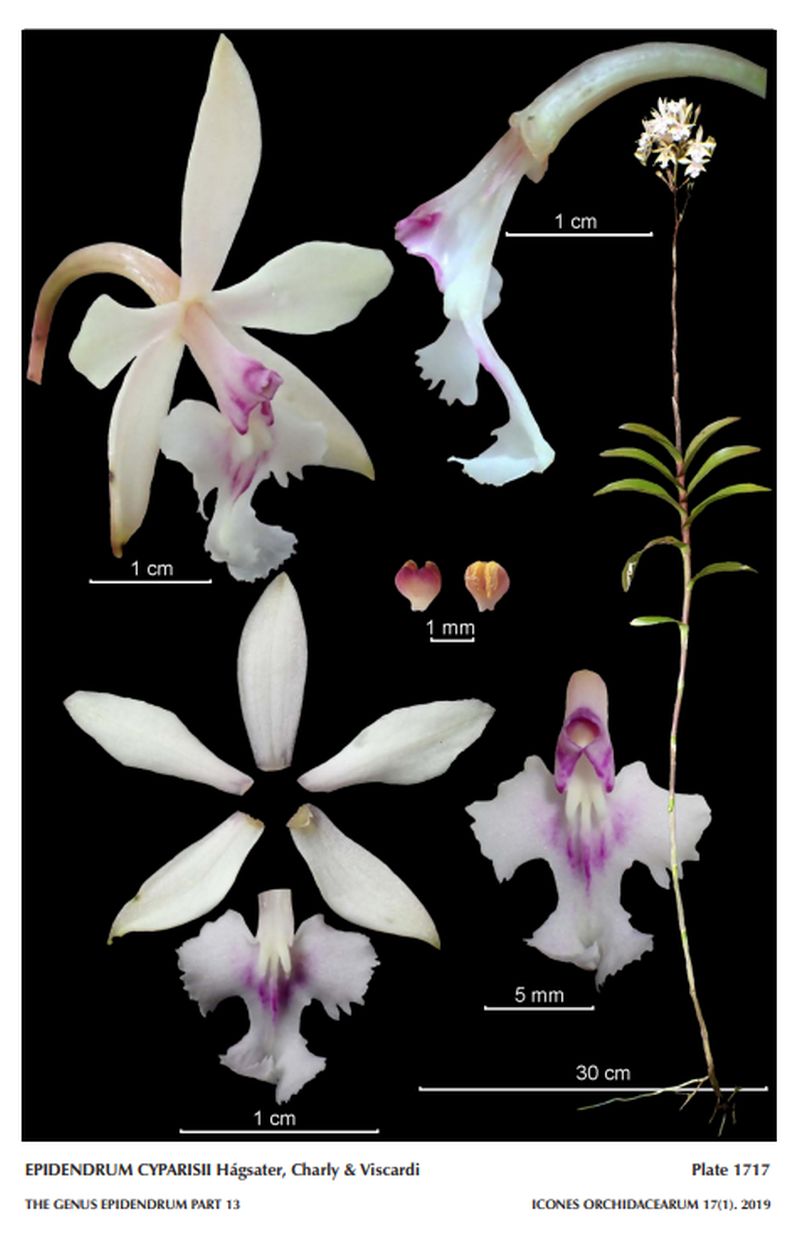

Epidendrum cyparisii Hágsater, Charly et Viscardi 2019 GROUP Secundum SUBGROUP Secundum
Plant and flowers in situ Martinique
LCDP Photo by © L. Charly/TYPE Photo by © L. Charly and AMO Herbaria Website

 LATE
LATE EARLIER
EARLIER 
Common Name Cyparis' Epidendrum [In honor of Louis-Auguste Cyparis, (Ludger Sylbaris, 1874-1929) one of the two survivors of the commune of St. Pierre, destroyed by the eruption of Mt. Pelée on May 8, 1902, destroying the town of St. Pierre and its 30,000 inhabitants. He survived thanks to his being imprisoned in an underground cell due to a brawl the night before, which protected him from the enormous pyroclastic cloud though he suffered horrible burns in his back, hands, arms and legs]
Flower Size .8" [2 cm]
Found in Martinique, from a single locality on the slopes of the Montagne Pelée in Martinique, in degraded volcanic sand with some humus, amongst low vegetation dominated by ferns, Lycopodium and Pitcairnia at elevations of 830 to 950 as a large sized, warm growing terrestrial with simple, cane-like, terete, straight stems, the basal part covered by several non-foliar sheaths, chartaceous, gray, imbricated, tubular and carrying 8 or more, distributed along the apical 1/4 of the stem; sheaths tubular, thin, smooth to slightly striated, purple; blade oblong-elliptic, apex emarginate, coriaceous, green, margin entire leaves that blooms in the late winter and earlier spring on a terminal, peduncle 6.8 to 8" [17 to 20 cm] long, elongate, terete, straight, purple, covered by 8 tubular bracts, chartaceous, grayish, imbricated, acuminate, 9.6 to 12.8" [24 to 32 cm] long, apical from the mature stem, simple to pluri-racemose, erect, producing 1 to 4 new racemes from the upper nodes of the peduncle, successively 5- to 12 open at a time with floral buds in various stages of development, many flowered inflorescence with much shorter than the ovary, triangular, chartaceous, acuminate, embracing floral bracts and carrying resupinate, white flowers with the apex of the column, anther and disc of the lip purple tinged, calli and mid-rib white; fragrance none.
"Epidendrum cyparisii belongs to the GROUP Secundum SUBGROUP Secundum which is characterized by the caespitose habit, erect, simple, cane-like stems, normally elongate peduncle of the inflorescence, erect raceme of resupinate, showy, colorful flowers, with the lip adorned by two calli and a median, narrow keel. The new species is recognized by the terrestrial habit, resupinate flowers white, with apex of the column, anther and disc of the lip purple tinged, calli and mid-rib white, petals ellipticrhombic, obtuse, lip deeply 3-lobed, base deeply cordate; lateral lobes oblique, rhombic, mid-lobe formed by a narrow isthmus in the basal half, apical half obliquely rhombic in outline, bilobed, the lobes divergent, sub-quadrate. It closely resembles E. calanthum Rchb.f. & Warsz., a widespread species of continental South America with smaller flowers, usually purple tinged but often with pure-white albino forms. Epidendrum × elongatum Jacq. is the natural hybrid between the new species and Epidendrum secundum Jacq. and produces all the intermediate shapes and colors, it has non-resupinate flowers which vary from bright pink to deep red, the callus anywhere from a large white, pluri-tuberculate callus to two narrow, yellow calli with a yellow mid-rib on reddish or pink flowers, the lip is always 3-lobed, but the shape can be anywhere between the shape of the two parents. Epidendrum revertianum (Stehlé) Hágsater, also native to Martinique, is also terrestrial [reported rarely epiphytic], sub-erect with compact leaves and has resupinate, white flowers with pale yellow calli and the lip orbicular in general outline, composed of four sub-equal lobes, the laterals more or less at a 45° angle. " Hagsater etal 2019
SynonymsReferences W3 Tropicos, Kew Monocot list , IPNI ; * Icones Orchidacearum 17(1) Plate 1717 Hagsater & Jimenez 2019 drawing/photo fide
--------------------------------------------------------------------------------------------------------------------------